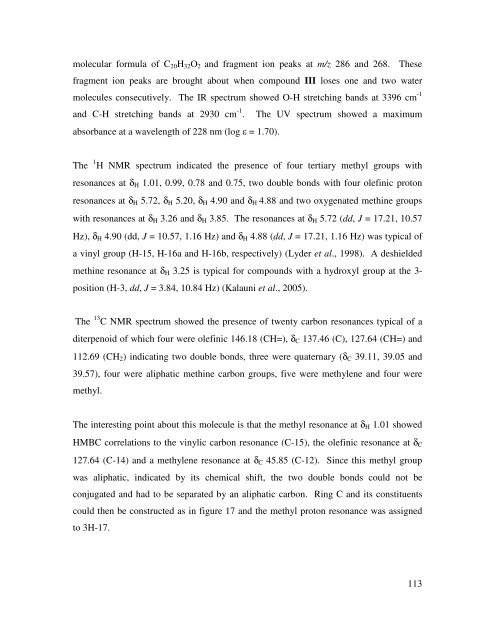university of kwazulu-natal faculty of science and agriculture school ...
university of kwazulu-natal faculty of science and agriculture school ...
university of kwazulu-natal faculty of science and agriculture school ...
Create successful ePaper yourself
Turn your PDF publications into a flip-book with our unique Google optimized e-Paper software.
molecular formula <strong>of</strong> C20H32O2 <strong>and</strong> fragment ion peaks at m/z 286 <strong>and</strong> 268. These<br />
fragment ion peaks are brought about when compound III loses one <strong>and</strong> two water<br />
molecules consecutively. The IR spectrum showed O-H stretching b<strong>and</strong>s at 3396 cm -1<br />
<strong>and</strong> C-H stretching b<strong>and</strong>s at 2930 cm -1 . The UV spectrum showed a maximum<br />
absorbance at a wavelength <strong>of</strong> 228 nm (log ε = 1.70).<br />
The 1 H NMR spectrum indicated the presence <strong>of</strong> four tertiary methyl groups with<br />
resonances at δΗ 1.01, 0.99, 0.78 <strong>and</strong> 0.75, two double bonds with four olefinic proton<br />
resonances at δH 5.72, δH 5.20, δH 4.90 <strong>and</strong> δH 4.88 <strong>and</strong> two oxygenated methine groups<br />
with resonances at δΗ 3.26 <strong>and</strong> δΗ 3.85. The resonances at δH 5.72 (dd, J = 17.21, 10.57<br />
Hz), δH 4.90 (dd, J = 10.57, 1.16 Hz) <strong>and</strong> δH 4.88 (dd, J = 17.21, 1.16 Hz) was typical <strong>of</strong><br />
a vinyl group (H-15, H-16a <strong>and</strong> H-16b, respectively) (Lyder et al., 1998). A deshielded<br />
methine resonance at δΗ 3.25 is typical for compounds with a hydroxyl group at the 3-<br />
position (H-3, dd, J = 3.84, 10.84 Hz) (Kalauni et al., 2005).<br />
The 13 C NMR spectrum showed the presence <strong>of</strong> twenty carbon resonances typical <strong>of</strong> a<br />
diterpenoid <strong>of</strong> which four were olefinic 146.18 (CH=), δC 137.46 (C), 127.64 (CH=) <strong>and</strong><br />
112.69 (CH2) indicating two double bonds, three were quaternary (δC 39.11, 39.05 <strong>and</strong><br />
39.57), four were aliphatic methine carbon groups, five were methylene <strong>and</strong> four were<br />
methyl.<br />
The interesting point about this molecule is that the methyl resonance at δH 1.01 showed<br />
HMBC correlations to the vinylic carbon resonance (C-15), the olefinic resonance at δC<br />
127.64 (C-14) <strong>and</strong> a methylene resonance at δC 45.85 (C-12). Since this methyl group<br />
was aliphatic, indicated by its chemical shift, the two double bonds could not be<br />
conjugated <strong>and</strong> had to be separated by an aliphatic carbon. Ring C <strong>and</strong> its constituents<br />
could then be constructed as in figure 17 <strong>and</strong> the methyl proton resonance was assigned<br />
to 3H-17.<br />
113

















